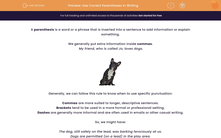A parenthesis is a word or a phrase that is inserted into a sentence to add information or explain something.
We generally put extra information inside commas.
My friend, who is called Jo, loves dogs.

Generally, we can follow this rule to know when to use specific punctuation:
Commas are more suited to longer, descriptive sentences.
Brackets tend to be used in a more formal or professional setting.
Dashes are generally more informal and are often used in emails or other casual writing.
So, we might have:
The dog, still safely on the lead, was barking ferociously at us.
Dogs are permitted (on a lead) in the play area.
Please feed the dog – just one tin – as I completely forgot.

The sentence should always make sense without the parenthesis, whether commas, dashes or brackets are used.
Sometimes, people use the word parenthesis to refer to the brackets themselves, but strictly speaking the parenthesis is the information, not the punctuation.
The plural of parenthesis is parentheses.
In this activity, we will look at how to use these correctly, so if you are ready, let's get started!
.jpg)







